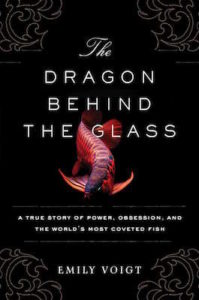Just what would you do for a pet fish? Would you pay $100 for one? $1000? $10,000? Would you lie? Cheat? Steal? Would you kidnap another person? Would you kill for one?
While this may seem hyperbolic, when it comes to the Asian Arowana, the subject of Emily Voigt’s The Dragon Behind the Glass; A True Story of Power, Obsession, and the World’s Most Coveted Fish, none of it is even slightly exaggerated. With prices that can reach into six figures and an international trade network that includes an exceptionally colorful assortment of fish enthusiasts, aquaculturists, entrepreneurs, government officials, and organized criminals, the story of the “dragon fish” is one that was ripe to be told; something Ms. Voigt does in a way that is both compelling and illuminating.
The Asian Arowana, Scleropages formosus, is one of the six members of the family Osteoglossidae (“boney tongues”). It inhabits – or at least inhabited – many of the tannin-rich fresh water lakes and streams of southeast Asia, particularly Indonesia and Malaysia. Possessing very large and semi-iridescent well-defined scales, long barbels, and a stream-lined, sinuous shape, it’s not at all difficult to understand how the species got its “dragon” nickname. Unfortunately, the association with dragons, long considered a symbol of good luck and good fortune in many Asian cultures, may have also led to its present status as not only the most expensive aquarium fish in the world but also its precarious status in the wild.
A CITES Appendix 1 listed species, the Asian Arowana has gone from a commonly found item on southeast Asian dinner tables to a highly coveted prize in the aquariums of some of the world’s wealthiest people. Now exceedingly difficult to find in the wild, their most common habitats are presently to be found in the robustly guarded ponds of aquaculturists who raise them for the lucrative (and sometimes shadowy) international pet fish trade. This is where Ms. Voigt begins recounting her intriguing story.
From tagging along with wildlife enforcement investigators in New York, to the world’s largest exhibition of aquarium fish – Singapore’s Aquarama (now held in Guangzhou, China), to some of the more challenging-to-reach regions of Indonesia, Malaysia, and… well, I don’t want to give too much away, and beyond, Ms. Voigt pursued both the fish as well as its fascinating and tragic story. Along the way she encountered flamboyant fish trade magnates, eccentric ichthyologists, and a modern day explorer straight out of the grand tradition of the great Victorian naturalists. She also came to discover just how slippery the idea of a species can be, how ecologically damaging the large-scale palm oil monoculture rapidly spreading across southeast Asia has become, and what effect even the most well-intentioned international wildlife protection agreements can have on the creatures they were established to protect.
Containing enough science to satisfy the curiosity and hold the interest of the dedicated naturalist reader as well as sufficient excitement, adventure, and mystery to make it highly enjoyable by a much wider audience seeking a genuine “page-turner” of a book, The Dragon Behind the Glass can truly be said to offer something for just about everyone.
 Title: The Dragon Behind the Glass; A True Story of Power, Obsession, and the World’s Most Coveted Fish
Title: The Dragon Behind the Glass; A True Story of Power, Obsession, and the World’s Most Coveted Fish
Author: Emily Voigt
Publisher: Simon & Schuster
Imprint: Scribner
Format: Hardcover
Pages: 336 pp.
ISBN 9781451678949
Published: May 2016
In accordance with Federal Trade Commission 16 CFR Part 255, it is disclosed that the copy of the book read in order to produce this review was provided gratis to the reviewer by the publisher.
